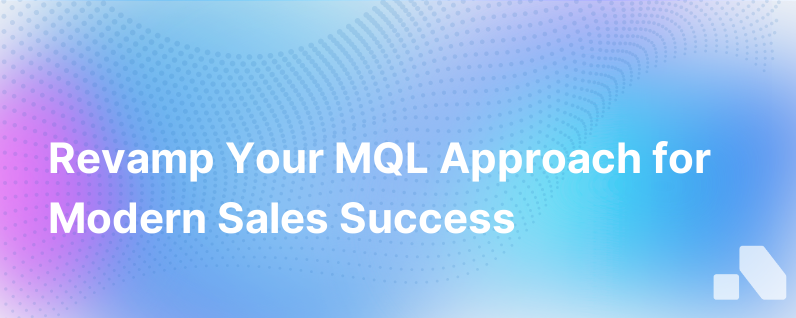2015 Called And Wants Its Mql Back
Published on September 7, 2023 by Sawyer Middeleer
In the cutthroat realm of B2B marketing, the stakes are perpetually high, and the tactics are forever evolving. A strategy or buzzword that reigned supreme just a decade ago may now be nothing more than a remnant of a bygone era. This is certainly the case with Marketing Qualified Leads (MQLs) as we knew them in 2015. It’s an outdated concept that barely scratches the surface of what modern marketing intelligence can achieve.
For years, MQLs have been the gold standard for measuring marketing team performance. Sales and marketing departments would rejoice at soaring MQL numbers, seeing them as harbingers of bountiful sales down the line. But as we dissect the remains of this antiquated model, it's apparent that the glory days of MQLs are in the rearview mirror – 2015 called, and it wants its MQL back.
Why the MQL No Longer Reigns Supreme
The traditional MQL is centered on engagement metrics – a form fill, a content download, or some other indication of interest. But interest doesn't pay the bills; conversion does. Given the complexity of today’s buyer journeys and the depth of intelligence available, relying solely on MQLs is like navigating a spaceship with a compass. It's insufficient, outdated, and ignores a universe of nuanced data.
The Shift in B2B Buyer Behavior The most striking distinction between now and 2015 is the transformation in how B2B buyers conduct their purchasing research. Buyers today are savvy, self-directed, and expect personalized engagement. They often traverse more than half the buying journey independently, without landing in an MQL bucket.
The Rise of Account-Based Marketing (ABM) Account-based marketing tactics that target key accounts with laser-focused strategies have risen in popularity. In an ABM strategy, the traditional MQL takes a backseat to engagement metrics at the account level, leading to better sales alignment and improved ROI.
Demand for Higher Quality Leads Sales teams are now less interested in quantity and more concerned with the quality of leads. They seek leads that show a higher likelihood of closing, and just "being interested" doesn’t cut it anymore. Factors like fit, intent, and engagement are increasingly crucial.
Technological Advances and Data Overload Marketers now have access to vast amounts of data and advanced AI tools that can mine insights and predict buying behavior at granular levels. This tech evolution has made the one-dimensional MQL metric seem myopic.
Refining Lead Qualification for the Modern B2B Landscape
So, what’s the modern marketer to do? We can't just hang onto MQLs for old times' sake. Our strategy must evolve.
Employ Predictive Lead Scoring Predictive scoring uses sophisticated machine learning algorithms to decipher complex data patterns and forecast which prospects are most likely to convert. It’s a step up from the basic demographic and firmographic scoring of yesteryears.
Embrace Intent Data Today’s marketers have the luxury of intent data – real-time insights into prospect behavior that signal their place in the buyer journey. By leveraging intent data, marketing teams can deliver more meaningful content and offers that resonate with where prospects are in their decision-making process.
Prioritize Lead Engagement Over Lead Generation As the adage goes, "quality over quantity." It is far more beneficial to nurture one lead showing promising engagement levels than to generate dozens of disinterested ones. High engagement is a better indicator of sales readiness.
Strengthen Sales and Marketing Alignment The sales department’s involvement shouldn’t start after Marketing hands over the leads. A symbiotic relationship throughout the buyer's journey ensures a unified approach to nurturing and converting leads.
Utilize Account-Based Engagement Metrics In the world of ABM, the focus is on accounts, not individual leads. Account-level engagement metrics give a holistic view of how an account is interacting with your brand, enabling a more concerted approach to push the collective decision-making unit towards a sale.
Interpret the Entire Digital Body Language Every digital interaction a prospective buyer has with your brand tells a story – what I like to call their "digital body language.” Understanding this language requires interpreting a complex web of digital touchpoints to intuit genuine interest, fit, and buying intention.
The Evolution Continues: What’s Next?
The arena of B2B marketing is subject to an unending march of progress. The future lies in a data-rich, AI-driven landscape where real-time decision-making is the norm. Lead qualification processes will become more sophisticated, relying on a confluence of advanced analytics, predictive modeling, and artificial intelligence.
In the end, what marketers should aim for is not just a lead, nor an MQL, but a holistic view of a prospect – a dynamic, multidimensional perspective that evolves with every interaction. In this view, data points are interconnected threads, woven into a detailed tapestry that dictates the unique approach needed for each potential deal.
Reflecting on 2015, let’s acknowledge that the era of using MQLs as a solitary success metric is past its prime. Much like in other fields, evolution is inevitable, and in marketing, it’s time we turn the page. Let’s look ahead to leveraging intricate, multi-threaded strategies that mirror the intricate ecosystem of buyer interests—bringing about engagements and conversions with a precision never before seen in B2B marketing.
Within this refreshingly complex environment, tools like Aomni emerge as critical assets for sales teams, as they deftly maneuver the maze of modern B2B sales, providing real-time account research, competitive insights, and personalized sales content that resonate with today’s buyers. It’s about bidding farewell to MQLs as we knew them and welcoming the sophistication and clarity of a future where lead enrichment goes beyond the superficial, into the very heart of strategic selling.